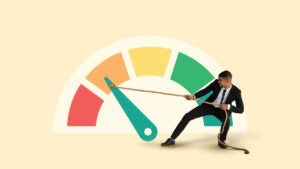Payday loan statistics

Payday loans are short term, high interest loans designed to give borrowers a quick cash advance in a pinch. For many who live paycheck to paycheck, struggle with debt or have bad credit, payday loans provide immediate funds that they may not qualify for elsewhere.
However, these loans come with a lot of risks, and the payday loan industry can be predatory. These loans can have a huge impact on an individual’s finances, so it is important to understand how payday loans work, who is using them and how they are using them before deciding to take one out. Bankrate has compiled the following statistics about payday loans in the U.S.
Payday loans statistics
- In the U.S., payday loans cost 4 times more in the states with fewer consumer protections.
- The average payday loan term is roughly two weeks.
- On average, one in five borrowers default on their payday loans.
- More than half of all borrowers who got their installment loans from an online lender default on their balance.
- 80 percent of borrowers who were tracked over 10 months rolled over or reborrowed payday loans within 30 days.
- As per the most recent CFPB data available, as many as 12 million Americans are estimated to take out a payday loan each year.
- As of 2022, payday loan lenders operate brick-and-mortar stores in 32 states.
- Idaho has the highest average payday loan APR in the nation at 652 percent.
- Payday lending is illegal in twelve states and has restrictions in eighteen states and Washington D.C.
- The average payday loan borrower can afford a payment that’s equivalent to 5 percent of their income.
- Four U.S. states – Colorado, Hawaii, Ohio and Virginia – have passed payday reforms to better protect consumers.
Who uses payday loans?
According to a Vantage Market Research report, the global payday loans market – driven primarily by an increase in payday lenders – was estimated to be worth roughly $33.5 billion in 2021. By 2028, the market is predicted to grow to $42.6 billion.
Despite the surge in overall popularity, there are certain demographics in the U.S. that are more likely to use payday loans than others, including:
- Those who are underbanked or don’t have access to a traditional bank account.
- Recent immigrants, undereducated individuals and those of Black or Hispanic descent.
- Young adults who took out student loans.
- Lower-income individuals.
- Parents, especially those who are divorced or separated.
Payday loans in America
The rates, terms and availability of payday loans will vary significantly depending on the state’s lending laws. In states that enact strict regulations, payday lending decreases and can be harder to find. According to the most recent Pew Research study, 2.9 percent of adults in states with stringent restrictions reported using payday loans in the past five years, while 6.3 percent of adults reported usage in moderately regulated states. Furthermore, 6.6 percent in states with the least regulation reported taking out a payday loan in the past five years.
Colorado, Hawaii, Ohio and Virginia passed payday lending reforms in 2010 to better protect consumers. These loans are smaller, are repaid in installments and cost four times less than single-payment loans.
32 U.S. states allow for in-store payday lending, with 27 issuing single-payment loans. In 22 states, single-payment loans dominate the payday lending market and in 13, they’re the only type of payday loan offered. In these states, payday loan APRs tend to be high and borrowers have few protections.
Eighteen states – including Washington D.C. – have either outlawed payday loans or have instituted an APR rate cap of 36 percent, making it virtually impossible for payday lenders to set up shop in these states.
Why do people use payday loans?
While payday loans are intended for emergency or unexpected expenses, it’s generally advisable to exhaust all other financing options first. Payday loans, especially single-payment loans, often come with sky-high interest rates and fees that can launch borrowers further into the cycle of high-interest debt.
Despite the intended payday loan usage, the majority (69 percent) of first-time borrowers reported using the funds to cover daily, ongoing expenses over multiple months. Sixteen percent reported using the money to cover an unexpected or emergency expense.
The 69 percent of people who took out a payday loan for recurring costs reported using the money for the following:
- Utilities
- Car payments
- Credit card payments
- Rent/mortgage payments
- Food costs
Payday loan alternatives
If you’re hit with an unexpected expense or need help getting back on your feet, payday loans aren’t the only way to get cash fast and should be avoided whenever possible. There are several alternatives to taking out a payday loan, including credit card cash advances, personal installment loans and loans with bad credit.
When compared to payday loans, the alternative options are generally more sustainable in the long-run; no matter your creditworthiness, they come with fewer fees and offer longer repayment terms. Even though interest rates will be on the higher side for borrowers with less-than-stellar credit, personal loan rates are capped at 36 percent – which is still high, but is lower than most payday loans’ rate caps.
The bottom line
While payday loans can seem helpful for those who find themselves struggling with unexpected bills or everyday expenses, it often feeds a cycle of never ending high-interest debt. Taking out one payday loan leads to taking out multiple, which often come with sky-high interest rates.
If you’ve exhausted all of your options and have come to the conclusion that a payday loan is the best route for your financial situation, make sure you know your state’s lending laws. In the states that have few lending regulations, payday scams are more common and lenders can easily take advantage of borrowers.
It’s also wise to research the lenders in your state to see which offers the lowest APRs and fewest fees. If you live in a state where it’s offered, consider taking out an installment loan over a single-payment loan to reduce the risk of interest accrual and defaulting on your balance.






